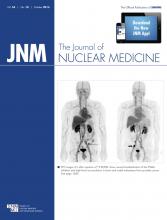TO THE EDITOR: We have read with great interest a recent article by Ceccarini et al. (1). In their study, the authors evaluated the sensitivity of a single PET scan with the high-affinity dopamine D2/3 receptor ligand 18F-fallypride to reward-induced dopamine release. Ceccarini et al. concluded that striatal and extrastriatal dopamine release can be measured using a single 18F-fallypride PET scan, if the timing and peak magnitude of the dopamine release are appropriate. Furthermore, their human PET and simulation experiments suggested that performance of a reward learning task during the scan, that is, during the interval in which radioligand binding occurs, induced displacement of the ligand in extrastriatal regions of the reward circuit, notably in the orbitofrontal cortex. These findings are generally in line with existing, albeit limited, literature on this theme; the report by Ceccarini et al. is of particular interest, being one of the first examining the dependence of competition on timing and magnitude of the endogenous dopamine release in the cerebral cortex.
The question of whether dopamine release can be captured in vivo is the theme of the well-established competition paradigm, notably on pharmacologic challenge with amphetamine. Indeed, amphetamine is a powerful releaser of dopamine, with a dose-dependent action that seems ideally suited to examine the sensitivity of radioligand binding to changes in endogenous dopamine concentration. Whereas amphetamine challenge evoked a reduction in 18F-fallypride binding in striatum of anesthetized mice (2) and likewise in awake humans (3), the evidence is substantially less compelling for extrastriatal binding sites of 18F-fallypride (4). Similarly, amphetamine challenge evoked only 5%–10% declines in the local cortical binding of the alternate high-affinity dopamine D2/3 ligand 11C-FLB 457 (5), whereas the same research group had earlier reported that a working memory task evoked widespread 10%–15% reductions in cortical binding of that ligand (6). In view of the well-known behavioral and physiologic effects of amphetamine, one might expect that amphetamine challenge should provoke a greater dopamine release than occurs during a cognitive task. Thus, it remains to be established how performing a cognitive task might evoke a greater or more prolonged decline in the availability of cortical dopamine D2/3 receptors than can be evoked by amphetamine. This same reservation seems relevant to the observations of reward/learning-dependent 18F-fallypride binding changes now reported by Ceccarini et al. Given that benzamide binding in living brain is influenced by changes in cerebral blood flow (7) and dependent on global perfusion (8), and in consideration that the blood oxygen level–dependent signal in orbitofrontal cortex is altered during reward processing (9), have the authors considered that their observations with 18F-fallypride PET might be vulnerable to confounds arising from altered cerebral perfusion? We suggest that this consideration may call for systematic preclinical investigation of the effects of focally altered cerebral perfusion, as may occur during performance of cognitive tasks, on cortical 18F-fallypride binding.
Footnotes
Published online Jun. 18, 2013.
- © 2013 by the Society of Nuclear Medicine and Molecular Imaging, Inc.







